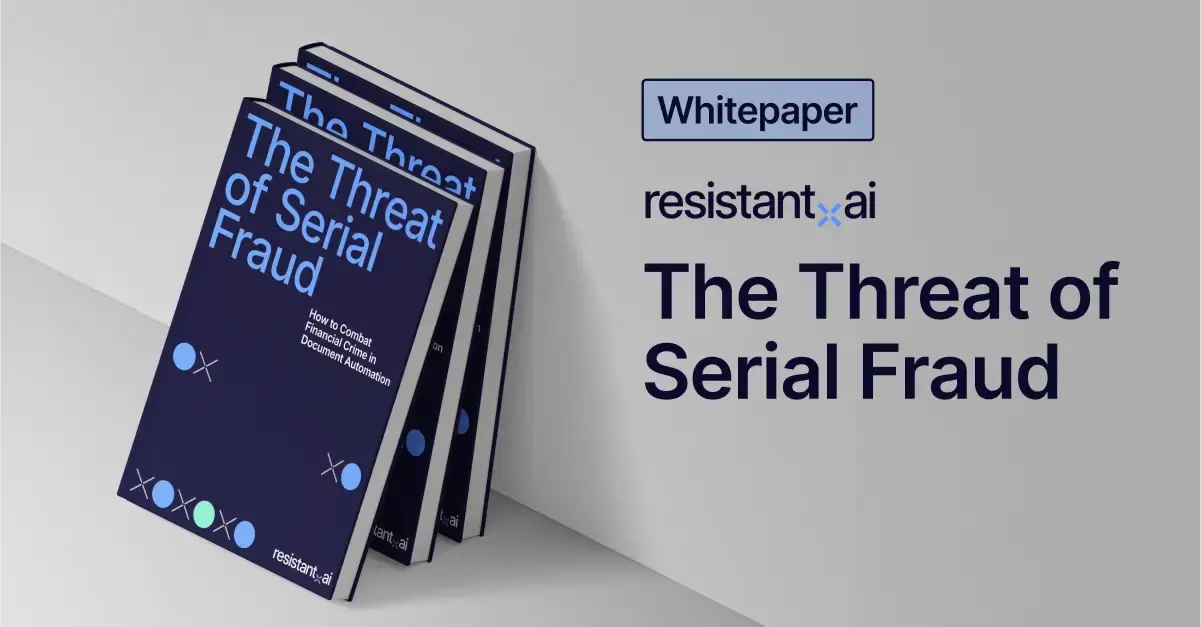Trade finance fraud: Ultimate guide



Trade finance enables roughly 80% of global trade, serving as the backbone for $25 trillion in annual transactions. By bridging the gap between buyers and sellers, it reduces payment, country, and counterparty risks that can stall international commerce.
But even risk mitigation has its limits. The International Chamber of Commerce estimates that up to 1% of trade finance transactions (valued at over $50 billion) are potentially fraudulent. For banks and financial institutions acting as trusted intermediaries, that’s a costly vulnerability hiding in plain sight.
But what does this mean for your business? In this blog we’ll go through the logistics of trade finance fraud, where it comes from, how it's being committed, and what you can do to stop it.
Read on to learn more.
What is trade finance fraud and how do you stop it?
What is trade finance fraud?
Trade finance fraud refers to a range of fraudulent activities that involve securing loans or funds illicitly under the disguise of facilitating international trade.
More specifically, trade finance is a document driven industry. Banking and non-banking institutions rely heavily on various documentation such as letters of credit, invoices (pro-forma & commercial), financial statements, identification documents, bills of lading, customs and export certificates, shipping and finance documents, etc. to provide trade funding and facilitate global transactions.
This reliance makes the industry particularly vulnerable to document fraud, as perpetrators exploit gaps in trade financing underwriting and other processes using fake templates or advanced techniques (like Gen AI fakes) in document falsification, fabrication, and forgery, costing the industry up to US $5 billion a year.
Fraudulent practices tend to include manipulation of trade documentation, financial details, and misrepresentation of trade transactions or cargo to obtain illicit financial gains often through fabricated, falsified, or forged documents. Cross-border transactions are some of the most commonly targeted since they are much harder to track and verify.
Real world example: A prime example is the Balli Steel Plc fraud case which amassed around $500M in debt across more than 20 financial institutions through fake shipping documents and forged signatures on sale contracts.
Industry context: What does fraud look like in the trade finance industry
Trade finance relies on documentation-heavy processes involving multiple parties across borders, making fraud within the industry notoriously hard to detect. Fraudsters leverage the complexity inherent in global trade: exploiting gaps in oversight, cumbersome verification processes, and the physical movement of goods.
From organized criminal syndicates, to complicit company insiders, to rogue traders acting alone, criminals inflate invoice values, falsify shipment records for non-existent or substandard goods, or duplicate transactions across multiple banks.
A common example involves letters of credit (LCs), essential documents banks use to guarantee payment from importers to exporters. Fraudsters might create a fictitious trade, presenting forged documents like invoices and bills of lading indicating shipment of high-value goods. Banks, relying on these falsified documents, issue payments under the assumption the goods have been shipped.
However, the shipment never took place, or the shipped goods were significantly less valuable. By the time the discrepancy is identified, funds have already been transferred into offshore accounts, quickly dispersed into various jurisdictions, making recovery nearly impossible.
The steps of trade finance fraud:
To understand more about trade finance fraud, let's look at how a typical fraud might occur:
.png?width=1200&height=1500&name=The_trade_finance_fraud_loop%20(2).png)
- Loan application submitted. Fraudsters apply for trade financing from a bank, claiming to have shipped goods under contract.
- Fake documents submitted. Forged bills of lading, commercial invoices, and letters of credit are used to “prove” the shipment.
- Transactions appear legitimate. Document verification appears to check out. Cargo seems real. Payment terms look correct.
- Loan approved and disbursed. The bank releases funds based on verified documents and expected goods delivery.
- Money moved or hidden. Funds are quickly funneled through shell companies, offshore accounts, or cash withdrawals.
- Fraud discovered too late. The bank realizes the shipment never existed, but the fraudster is already gone.
Who is responsible and who is affected?
There are several parties involved in any successful trade finance fraud:
Key bad actors include: Rogue businesses, corrupt intermediaries, fraudulent importers or exporters, and even corrupt port officials.
More sophisticated crimes may also infiltrate supply chains or collude with insiders at banks, trading houses, or logistics companies to bypass compliance checks.
Victims include: Banks, financial institutions, and legitimate businesses suffering significant financial losses and reputational damage from the products and money lost along the way.
Recovery or reimbursement is highly challenging and often unsuccessful. Banks or companies may have recourse through insurance claims, legal actions, or regulatory interventions (but these avenues typically require significant time, resources, and cross-jurisdictional cooperation).
Successful reimbursement is possible only when fraud is detected early with rapid identification, effective collaboration between international law enforcement agencies, or freezing of accounts before funds are withdrawn. However, in the majority of cases, by the time fraud is identified, assets have already moved beyond reach, making full recovery highly improbable.
Why is trade finance vulnerable to fraud?
Perhaps, that’s why criminals are drawn to trade finance. It has high-value transactions and illicit activities are easy to obscure within genuine trade flows. Additionally, international trade frequently crosses jurisdictions, complicating enforcement and legal recourse. With transactions moving rapidly through multiple banks and intermediaries, it becomes nearly impossible to unravel once funds have moved.
Some of the trade finance industry's vulnerability lies in its dependence on paper-based documentation and manual verification processes. Traditional practices like physical inspection of shipments, manual reviews of paperwork, and reliance on intermediaries significantly increase fraud risk due to their slowness and susceptibility to human error and corruption.
Currently, many banks and financial institutions still depend on outdated compliance procedures, inadequate digital systems, and fragmented oversight. By the time fraudulent activity is identified, perpetrators have typically withdrawn funds and dissolved their connections to the transaction, leaving limited avenues for recovery.
Fraud’s impact on the trade finance industry
When fraudsters exploit trade loans or fabricate shipment documents, the damage ripples through the entire financial system.
From billion-dollar bank losses to geopolitical tensions and supply chain breakdowns, the impact is systemic. What begins as a forged invoice or ghost shipment can undermine trust, raise the cost of doing business, and even push major lenders out of the market entirely.
Below are some of the most significant consequences of unchecked fraud in the trade finance ecosystem.

Financial & reputational losses
Trade finance fraud can trigger massive financial losses and loss of trust in institutions that enable global commerce. When a single fraudulent trader secures large volumes of financing using fake documents or nonexistent shipments, the resulting fallout can bankrupt counterparties and tarnish entire portfolios.
One of the most notorious examples occurred in Singapore, where multiple banks lost between $400 million and $600 million each due to fraud linked to the Hin Leong trading scandal.
The scale of the deception forced a reckoning in the industry. Major players like ABN Amro, BNP Paribas, Société Générale, Natixis, and ANZ have since exited the commodity trade finance market altogether in an effort to contain further exposure.
These exits reflect a broader truth: beyond balance sheet losses, fraud undermines institutional credibility. Investor confidence, customer trust, and market reputation all take a hit, compounding the cost of fraud long after the initial loss is recorded.
Impacted international relations
Trade finance fraud doesn’t just affect banks. It can strain diplomatic ties and disrupt global commerce. When fraudulent transactions lead to legal disputes, shipment delays, or cargo seizures, supply chains break down and trust between trading partners erodes.
These ripple effects can trigger trade barriers, escalate regulatory scrutiny, or sour bilateral agreements.
Repeated fraud cases can also lead to “de-risking:” banks pulling back from financing trade in emerging markets to avoid compliance exposure.
While this helps institutions meet anti-money laundering (AML) and counter-terrorism financing (CTF) obligations, it also sidelines legitimate businesses in less developed regions, weakening international trade cooperation and widening financial inclusion gaps.
Higher cost to trade
Trade finance fraud directly drives up the cost of doing business across borders. As fraud risks increase, so do trade credit insurance premiums. Many of which have risen by as much as 30% in response to geopolitical instability and repeated loan losses. These elevated costs are passed down the chain, making global trade more expensive for everyone involved.
Lenders now operate in a riskier environment, facing threats ranging from payment defaults and raw material price swings to country-specific instability and currency fluctuations.
At the same time, rising fraud rates have forced banks to invest more heavily in compliance, verification, and fraud prevention. These efforts (while necessary) add further overhead to each transaction, reducing margins and making legitimate trade harder to finance profitably.
Economic downturn
Trade finance fraud contributes to a widening global funding gap that threatens long-term economic growth. In 2022, this gap ballooned to $2.5 trillion as the world continued recovering from the pandemic. But instead of stepping in to close it, many banks began stepping back.
As we already mentioned, institutions like ABN Amro, BNP Paribas, Société Générale, Natixis, and ANZ have exited parts of the trade finance market altogether. As more lenders follow suit, access to capital tightens for legitimate traders, especially in emerging markets.
The result is a downward spiral: fewer funding options for importers and exporters, slower trade flows, and weakened economic development. In pulling back to protect themselves, financial institutions may be unintentionally stalling the very global growth they once helped enable.
6 Types of trade finance fraud
Since trade finance fraud is a broad term, being specific helps make fraud detection easier.
Here are the most common forms of trade financing fraud:
1. Document fraud
Document fraud in trade finance involves forging or falsifying documents to illegally secure trade funding from lenders or financial institutions. A 2023 article states that traders, lenders, and banks have lost over USD$9 billion in the last decade to falsified documents in trade finance.
Fraudulent documents can surface at various stages of a transaction, primarily to deceive lenders. But lenders aren't the only victims; fraudulent documents are also used to bypass compliance checks, mask the origins of goods, inflate the value of collateral, or obscure the financial health of counterparties.
While the stakes can be extremely high (like multi-million dollar trade finance schemes) even lower-value frauds can aggregate into substantial operational costs and compliance penalties.
Some of the most common documents used in trade finance fraud are:
Letter of credit
Letter of credit fraud occurs when these critical trade finance documents are fabricated, forged, or falsified to support phantom shipments, incomplete deliveries, or malicious schemes intended for financial gain. A notorious example is the Vesttoo case, where forged letters of credit issued by a prominent Chinese bank resulted in approximately $4 billion in losses.
Letter of credit fraud typically manifests in four primary ways:
- Non-existent shipments. Fraudsters fabricate shipments and falsify supporting documents, including product certificates, bills of lading, and customs documents, submitting them to banks to trigger payment.
- Incorrect shipment details. Delivered goods intentionally fail to meet the agreed quantity or quality, breaching the terms of the original letter of credit.
- Duplicate sales. The same physical shipment or documentation is deceitfully used to secure multiple payments from different buyers simultaneously.
- Fake connections. Perpetrators falsely claim international business ties or financial industry connections to deceive stakeholders into investing substantial sums in non-existent trade deals.
Invoices
In trade finance, invoices come in two forms: pro-forma and commercial invoices. While these invoices differ, both types are susceptible to fraud when forged or falsified for illicit financial gains. Common types of invoice fraud in trade finance include:
- Ghost invoicing: Bad actors create fake invoices and send them to lenders to obtain illegitimate trade funding, often for shipments that don’t exist. This type of fraud frequently targets larger lenders and banks.
- Fresh air invoicing: A company issues an invoice claiming full delivery of goods to receive payment from trade finance firms, even though it hasn’t fully met its contractual obligations.
- Duplicate financing: Fraudsters submit the same genuine invoice to multiple lenders to fund the same transaction several times, relying on authentic documents, rather than forged ones.
- Trade factoring fraud: Companies commit factoring fraud by submitting invoices from fictitious debtors to trade receivable financing firms. This can occur when businesses have no intention of repaying the loan or when they need short-term cash flow support.
Warehouse receipts
Warehouse receipts serve two purposes:
- Confirm shipments after an inspector verifies its specifications.
- Collateral for trading.
In the trading industry, bad actors frequently use fake warehouse receipts to secure illicit funds through:
- Ghost shipments. Fraudsters create receipts for goods that don’t exist or were never stored in the warehouse. These fictitious inventories are used to obtain financing or credit from banks based on non-existent collateral.
- Misrepresented cargo. The goods physically stored differ from what’s described in the receipt. For example, low-grade materials might be passed off as premium products, or a single type of commodity might be falsely labeled as a valuable mixed batch.
- Underweight shipments. The actual weight or volume of goods is significantly less than what’s stated on the warehouse receipt. This lets fraudsters overstate the value of the collateral, inflating their borrowing capacity or misrepresenting fulfillment to buyers.
In one high-profile case, a company in the metals commodity trade finance sector, Man Capital Markets (MCM) suffered a loss of $284M.
Bills of lading (BOLs)
Fraudsters manipulate bills of lading to obscure the movement of goods, disguise illicit shipments, or exploit financing loopholes. These forged or falsified documents can facilitate cargo theft, phantom trades, or double pledging of collateral. Here are four common BOL fraud schemes:
- Fabricated bills of lading. Fraudsters create entirely fake BoLs for shipments that never occurred, using forged carrier stamps, fictitious company names, or non-existent ports to secure financing or mislead counterparties. BoLs can also be altered to misstate the quantity, value, or condition of the cargo to hide damage, inflate value for trade financing, or mislead import/export authorities.
- Ransom BOL scams. Illegitimate freight agents pose as intermediaries and withhold original BoLs after pickup, demanding unauthorized payments from shippers or consignees in exchange for cargo release.
- Double pledging. A single BoL is fraudulently presented to multiple lenders as proof of collateral to obtain duplicate financing: a common tactic in complex, multi-party trade deals.
2. Shell companies
Shell companies are a trade finance fraud strategy where experienced fraudsters launder money through a fictitious business ‘front’ (like $4.5B being misappropriated in the 1MDB scandal).
These “ghost” firms have zero business operations and lack a physical office, employees, profit, ongoing activities, or office administration, allowing bad actors to transfer and transmit funds that appear legitimate without an actual trade taking place.
It is commonly executed through the issuance of fake invoices for phantom cargo and services, creating confusing money trails or conducting circular trading amongst the same fake companies to create an illusion of high sales and financial wealth.
In more complex situations, seasoned perpetrators can go as far as layering transactions into a complicated web that makes tracing the origin or destination of products and payments impossible.
3. Abuse of trade loans
Trade loans are designed to fund the movement of goods across borders, but not all borrowers use them as intended. In one common scheme, companies divert loan proceeds away from the underlying transaction, using the funds to cover unrelated expenses or prop up struggling operations. This diversion leaves the trade underfunded or entirely unexecuted, putting lenders at risk.
A more sophisticated variant involves “phantom trades.” Fraudsters fabricate entire transactions using fake invoices, purchase orders, and warehouse receipts to secure financing. These “ghost deals” may never involve actual goods or services. The goal is simply to extract funding and disappear before repayment is due.
4. Trade-based money laundering (TBML)
Trade-based money laundering is a form of global trade finance fraud where criminals use international trade to hide the origins of illicit funds by moving them across borders in seemingly legitimate business transactions.
With over 150,000 money laundering accounts in APAC alone, TBML usually involves document fraud and other defrauding techniques such as:
- Forged or fake freight documents: Fictitious invoices, purchase orders, warehouse receipts, etc are used to disguise the transfer of illicit funds or to ‘wash’ money through trade transactions.
- Over- and under-invoicing. Goods or services are deliberately mispriced (far above or below market value) to shift value between parties.
- Over-invoicing. Moves excess funds out of a jurisdiction.
- Under-invoicing. Hides the value of imports.
- Circular trading. The same goods are sold through a chain of intermediaries and eventually back to the original exporter. This creates a web of trade flows that appear legitimate but are designed to obscure the origin and destination of illicit funds.
- U-turn or “U-boat” shipments. Goods are documented as heading to a legitimate third country but are secretly rerouted back to their origin. This creates the illusion of cross-border trade while laundering money through freight payments and logistics costs.
Trade-based money laundering tends to lead to more sinister activities such as drug, arms, and human trafficking, or terrorism. These dire stakes make it essential for traders to strengthen their anti-money laundering regulations to drive transparency and keep illicit activities at bay.
5. Counterfeit goods
Counterfeit goods represent a significant type of trade finance fraud, approximately 86 million counterfeit trade items were seized in the EU in 2022 alone, valued at over $2.2 billion.
This fraud involves presenting pirated or counterfeit products as legitimate branded goods to deceive buyers, securing loans for goods that lack real market value. Counterfeit goods fraud is typically carried out through three methods:
- False branding: Exporters misrepresent counterfeit goods as legitimate branded products to defraud both end customers and lenders in order to secure trade funding under false pretenses.
- Mislabeling: Counterfeit cargo is intentionally mislabeled to bypass trade restrictions, tariffs, and custom requirements to command higher prices.
- Dropshipping abuse. Instead of importing goods and holding inventory, they act as middlemen, securing financing based on inflated or fake purchase orders, then directing low-cost or counterfeit goods (often from overseas suppliers) straight to the buyer. This bypasses key parts of the trade transaction and undermines the lender’s ability to verify the value, quality, or even existence of the underlying goods.
6. Advanced payment fraud
Buyers pay upfront but receive either substandard goods or no goods at all. This fraud exploits the fact that sellers are fully paid in advance. The two primary methods are:
- Non-delivery of goods: Buyers make an advanced payment but never receive the shipment, as the seller disappears with the funds.
- Partial delivery: The seller only ships part of the order, often with inferior quality, quantity, or branding, despite receiving full payment.
Real trade finance documents and how they’re used for fraud
Let’s look at some real trade finance documents to see how they’re used for fraud.
1. Bill of lading

These documents are not real, but recreations meant to demonstrate the fraud techniques described for illustrative purposes only.
Bill of lading fraudsters alter the shipper or destination fields to conceal that goods are being routed from or to a sanctioned country. If the bank accepts this forged document, it could unwittingly finance a transaction that breaches international sanctions, exposing the institution to severe regulatory fines and reputational damage.
2. Certificate of insurance

These documents are not real, but recreations meant to demonstrate the fraud techniques described for illustrative purposes only.
A common certificate of insurance fraud involves a party altering the document by adding or inflating an insurance clause, deceiving the bank into believing an uninsured or underinsured shipment is secure, advancing funds against collateral that is not actually protected.
3. Certificate of origin

These documents are not real, but recreations meant to demonstrate the fraud techniques described for illustrative purposes only.
Fraudsters manipulate certificate of origin documents by altering fields like weight to enable over-invoicing schemes or by changing the port of origin to bypass trade restrictions. Banks may lend against overstated collateral or unknowingly facilitate prohibited trade, creating both financial and compliance risks.
4. Packing list

These documents are not real, but recreations meant to demonstrate the fraud techniques described for illustrative purposes only.
A key fraud risk occurs when packing lists are backdated to falsely fit within a shipping window required by a Letter of Credit, tricking the bank into financing a non-compliant shipment or releasing payment for goods that were never actually shipped.
5. Export declaration
.png?width=1033&height=1337&name=export%20declaration%20demo%20doc%20(1).png)
These documents are not real, but recreations meant to demonstrate the fraud techniques described for illustrative purposes only.
Export declaration fraud involves inflating the unit counts and total value on this document to obtain a larger financing amount than the goods are actually worth, exposing the bank to direct credit loss, as its funds are now overstated relative to the actual collateral (and increases its AML exposure since over-invoicing is a classic money laundering technique).
Compliance in the trade finance industry
Compliance in trade finance is governed by umbrella frameworks such as anti-money laundering (AML), know your customer (KYC), and countering the financing of terrorism (CFT).
At the core of these compliance requirements is the fight against trade-based money laundering (TBML), the primary link connecting the trade finance industry to broader financial crime legislation.
Several key regulatory frameworks address these challenges, including:
- The Bank Secrecy Act (US).
- AML directives (EU).
- Financial Action Task Force (international standards).
These regulations enforce stringent customer verification requirements, transaction monitoring, and reporting of suspicious activities.
Additionally, industry-specific guidelines from bodies such as the Wolfsberg Group and ICC/BAFT provide targeted principles and best practices explicitly designed to identify and prevent TBML.
What legislation is specifically tailored to trade finance?
While standalone legislation targeting only trade finance is uncommon, several initiatives and guidelines explicitly address TBML and related fraud within trade finance transactions:
- Trade Transparency Units (TTUs). The U.S. Department of Homeland Security operates specialized units known as TTUs, which are designed to identify trade-based money laundering by correlating trade documentation and financial transactions across borders. These units leverage cooperation between customs authorities, financial intelligence units, and law enforcement to pinpoint suspicious trade activities and prevent fraudulent transactions.
- FATF TBML guidance and typologies. The Financial Action Task Force regularly issues guidelines specifically focused on trade-based money laundering. These include detailed risk indicators, real-world case studies, and specific typologies that institutions can utilize to enhance detection and reporting procedures. Although advisory, FATF’s recommendations significantly influence national legislation and regulatory oversight worldwide.
- UNCITRAL Model Law on Electronic Transferable Records (MLETR). Adopted in 2017, the MLETR aims to digitize and modernize trade documentation, such as bills of lading and warehouse receipts. By creating legally valid electronic documents, this initiative reduces opportunities for document fraud, improves transparency, and enhances traceability in trade finance.
- UK Economic Crime (Transparency & Enforcement) Act 2022. While broader in scope, this legislation emphasizes transparency regarding beneficial ownership and corporate registries. By exposing shell companies commonly exploited in TBML schemes, this Act indirectly but significantly reduces the risks and vulnerabilities within the trade finance ecosystem.
These targeted measures collectively represent the most direct legislative and regulatory responses to vulnerabilities unique to trade finance. Together, they form a crucial layer of defense against increasingly sophisticated trade finance fraud schemes.
How to detect and prevent trade finance fraud
Trade finance fraud thrives in complex supply chains and fragmented documentation. Preventing it requires proactive controls at three levels: document verification, transaction monitoring, and counterparty risk assessment. Resistant AI helps you scale all three automatically, intelligently, and at speed.
Detect document fraud with AI
Trade finance fraud starts with paperwork: fake invoices, forged bills of lading, altered warehouse receipts, certificates of incorporation, and more. Manual reviews struggle to keep up (especially when fraudsters use generative AI or cloned templates to mimic real documents).
Resistant Documents detects signs of forgery invisible to the human eye. Our system analyzes structural, behavioral, and metadata patterns to uncover synthetic documents, tampering, or copy-paste fraud across:
- Invoices and purchase orders
- Letters of credit and bank guarantees
- Freight documents and certificates
- Warehouse receipts and insurance records
- Any other trade finance verification documents!
Rather than “reading” documents, our solution analyzes how they were built, flagging layout reuse, field anomalies, and manipulated generation histories in milliseconds. Modern fraudsters don’t just change numbers — they generate entire documents from scratch.
These AI-powered fakes are designed to pass human review and mimic the style of legitimate trade documents down to the pixel. Only AI trained to detect structural and behavioral patterns—not just content—can catch them reliably and at scale.
Monitor trade transactions in real time
Fraud doesn’t stop at paperwork. Sophisticated schemes use legitimate-looking transactions to move money across borders under false pretenses.
Resistant Transactions continuously monitors trade activity to detect suspicious behaviors, such as:
- Duplicate financing across multiple lenders
- Circular trade routes and ghost shipments
- Unusual trade flows tied to known fraud templates
- Sudden shifts in counterparties or transaction velocity
With built-in behavioral analytics and cross-document context, our system detects patterns that manual reviews or traditional rules engines miss, helping you flag high-risk activity before it becomes a loss.
Build a trusted vendor network with reliable merchant onboarding
Know your business (KYB) checks are critical for reducing counterparty risk. Resistant AI enhances KYB workflows by helping you validate vendor legitimacy and detect high-risk patterns early.
- Verify registration data, tax IDs, and ownership structures.
- Flag vendors linked to duplicate or suspicious document submissions.
- Spot signs of shell entities or newly created import/export fronts.
Our document and transaction analysis tools can be integrated into your onboarding and compliance workflows—helping you assess trustworthiness without adding friction.
How trade finance fraud is evolving
Trade finance fraud is entering a new era. Here’s how the landscape has shifted, where it originated, and what’s on the horizon:
The past
Historically, trade finance fraud centered on paper-based schemes: forged invoices, fake bills of lading, inflated letters of credit, and shell companies generating phantom shipments. These schemes operated through manual processes, relied heavily on human error, and were easier to detect (or at least trace) once discovered.
What’s changing
Now, technology is both a tool for fraudsters and defenders. Fraudsters are leveraging generative AI to create more convincing fake documents, deepfakes for identity spoofing, and even automated fraud playbooks. At the same time, enforcement is ramping up: regulators are targeting high-impact trade frauds, and institutions are adopting AI-based detection tools to close gaps in trust and transparency.
Emerging techniques & tactics
Below you’ll find some of the newest strategies criminals are using to victimize institutions:
- Synthetic identities and AI-crafted documentation. Fraudsters are using generative AI to produce hyper-realistic documents and authentic-looking identities, making human validation nearly obsolete. Institutions must adapt to AI-driven fraud just as quickly as adopting AI for defense.
- Hidden receivables finance scams & shelf companies. Smaller, sophisticated scams (especially in receivables financing) are emerging with shell companies and opaque networks. These non-bank channels often lack oversight and have become fertile ground for repeated invoice and financing abuse.
- Commodity fraud with misrepresented cargo. Recent high-profile cases, like Trafigura’s alleged nickel and fuel fraud schemes (over $600M and $500M, respectively), reveal how cargo substitution, forged shipping documentation, and credit manipulation are weaponized in large-scale trade finance fraud.
- Regulatory crackdown and prioritization. Enforcement agencies like the U.S. Department of Justice now identify trade and customs fraud (including tariff evasion and TBML) as top-tier priorities. Firms are encouraged to self-report for leniency, and senior executives in long-running fraud schemes are being targeted.
What's next? The future of trade finance fraud
Trade finance fraud is still evolving. Lets analyze some of emerging trends to keep an eye on in the coming years:
- AI both weapon and shield. Fraudsters will automate deepfake documents and transactional schemes, while institutions turn to explainable AI, blockchain analysis, and federated learning to detect anomalies reliably without compromising privacy.
- Real-time vessel and shipping data analytics. Fraud detection will increasingly rely on integrating physical world data (e.g. ship tracking, unusual shipping routes) with financial patterns to flag TBML schemes in transit.
- Global standardization of digital documents. Adoption of URDTT, UNCITRAL’s MLETR, and digital bill-of-lading frameworks will help eliminate paper-based vulnerabilities, enforce traceability, and reduce forgery risks.
- Collaborative ecosystems. As fraud becomes more scattered across private fintech and non-bank lenders, defenders must respond with shared intelligence, data-sharing protocols, and cross-border cooperation (particularly via initiatives like Trade Transparency Units, industry consortia, and regulatory harmonization).
Trade finance fraud: industry challenges
Detecting and preventing trade finance fraud presents unique challenges due to the complexity and global nature of the industry. Here are the top five industry-specific obstacles:
- Heavy reliance on physical documentation. The industry's dependency on manual, paper-based verification processes creates significant vulnerabilities to document forgery, manipulation, and human error.
- Fragmented oversight and jurisdictional complexity. Cross-border transactions involve multiple jurisdictions, regulators, and intermediaries, resulting in fragmented oversight that makes effective monitoring and rapid fraud detection difficult.
- Lack of standardization and digitization. The absence of universal standards for digital trade documents leads to inconsistencies in documentation, verification practices, and transaction monitoring, creating gaps that fraudsters readily exploit.
- Difficulty of real-time verification. Traditional verification methods—such as manual document checks and physical inspections—are slow, resource-intensive, and fail to provide the real-time insights needed to identify and stop fraud before funds move.
- Advanced techniques and emerging technology used by fraudsters. Criminals increasingly leverage generative AI, deepfakes, templates, and automated systems to create sophisticated fraudulent documents and synthetic identities, rapidly outpacing traditional detection methods.
Top takeaways for fraud experts
Trade finance fraud is complex, costly, and deeply integrated into global trade. Here are four key insights fraud experts should keep in mind:
- Document fraud is central. The trade finance industry's heavy reliance on documentation (letters of credit, invoices, bills of lading) makes it uniquely vulnerable. Fraud typically begins with falsified, forged, or manipulated documents to deceive financial institutions and bypass compliance measures.
- Cross-border complexity amplifies risk. International transactions involve multiple jurisdictions, making fraud easier to commit and harder to detect or prosecute. Criminals exploit fragmented oversight, jurisdictional boundaries, and slow manual verification processes to evade detection and quickly move illicit funds offshore.
- Financial and reputational damage is severe (and recovery rare). Fraud in trade finance doesn't just lead to significant monetary losses; it also damages institutional trust and relationships, sometimes prompting major lenders to withdraw from the market entirely. Successful fund recovery is possible but uncommon, often requiring early detection, rapid international cooperation, and immediate action.
- New tactics are exploiting regulatory blind spots. From U-turn shipping schemes and hidden receivables finance scams to synthetic IDs and AI-faked KYB data, fraudsters are evolving faster than traditional defenses. Without structural document analysis or behavioral analytics, many of these attacks go undetected until it’s too late.
- Early detection is the only reliable path to recovery. Once trade finance fraud is executed, reimbursement is rare. Recovery depends on immediate detection and intervention (before funds are laundered through offshore accounts or disbursed across layered shell companies). Advance, AI-powered fraud detection tools are the only way to get there.
Conclusion
From forged freight documents to phantom shipments, every unchecked transaction erodes trust in the global trade ecosystem. And as fraud tactics grow more sophisticated, traditional defenses—manual reviews, static templates, isolated checks—no longer hold the line.
Resistant AI helps banks, lenders, and trade platforms move from reactive detection to proactive defense. By combining structural document analysis, real-time behavioral monitoring, and cross-party intelligence, we make it possible to spot trade finance fraud before it spreads.
Scroll down to book a demo.
Frequently asked questions (FAQ)
Hungry for more trade finance fraud content? Here are some of the most frequently asked questions from around the web.
What are the most commonly forged documents in trade finance fraud?
The most commonly forged documents in trade finance fraud include:
- Bills of lading
- Letters of credit
- Commercial and pro-forma invoices
- Warehouse receipts
- Inspection certificates
- Customs declarations
Who needs to detect trade finance fraud?
Anyone involved in onboarding clients, verifying trade documents, or financing cross-border shipments plays a critical role in identifying forged paperwork or suspicious behavior in global trade transactions.
Specifically, trade finance fraud must be detected by:
- Banks
- Non-bank financial institutions
- Trade credit insurers
- Logistics providers
- Compliance officers
- Corporate risk teams
What countries experience the most trade finance fraud?
Countries with large trade volumes, complex supply chains, and limited oversight are most vulnerable to trade finance fraud. These often include China, India, Singapore, the United Arab Emirates, and Nigeria alongside financial hubs like the United Kingdom and the United States.
What is AML in trade finance?
AML (Anti-Money Laundering) in trade finance refers to the regulatory frameworks and controls designed to prevent the use of international trade transactions for laundering illicit funds. It includes customer due diligence (KYC/KYB), transaction monitoring, and detecting red flags such as over-invoicing, phantom shipments, or fake documentation.
What are the red flags of trade finance fraud?
Trade finance fraud is a nuanced crime with many different approaches and formats. That being said, some of the most common trade finance fraud red flags include:
- Mismatched shipment and payment terms.
- Unusually high invoice values.
- Duplicate documentation submitted to different lenders.
- Altered or inconsistent document formatting.
- Unverified counterparties.
- Suspicious shipping routes or timelines.
Is there software to detect trade finance fraud?
Yes, there is advanced software designed to detect trade finance fraud. Resistant AI is a leading provider of AI-powered document and transaction analysis tools that flag forged trade documents, synthetic identities, and suspicious transaction patterns in real time. By analyzing structural, behavioral, and metadata signals across trade paperwork, Resistant AI helps banks and lenders stop fraud before funds move.
What are trade finance compliance risks?
Trade finance compliance risks are defined as the potential financial and reputational damages a firm could face for failing to comply with applicable laws and regulations.
What is loan underwriting in global trade and receivables finance?
Loan underwriting in global trade and receivables finance refers to the process of financial institutions assessing the creditworthiness of businesses engaged in international trade. It also incorporates the 3Cs of underwriting but for a niche market in international trade and receivables finance.
How to protect against fraud in trade finance?
The best way to protect against fraud in trade finance is through a multi-layered approach. This approach should include the digitization of data, sharing of data across similar businesses (to increase vigilance within the industry), and the automation of fraud detection and transaction monitoring.
Citations
Asian Development Bank. (2022). Global trade finance gap expands to $2.5 trillion. Retrieved from https://www.adb.org/news/global-trade-finance-gap-expands-25-trillion-2022
Atkins, J. (2023, January). After the fraud: Americas case. Global Trade Review. Retrieved from https://www.gtreview.com/magazine/the-commodities-issue-2024/after-the-fraud/
BAFT. (n.d.). Certified Trade Finance Professional. Retrieved from https://www.baft.org/education-training/affiliates/certified-trade-finance-professional/
Basquill, J. (2024, December 3). Trade finance’s latest fraud problem. Global Trade Review. Retrieved from https://www.gtreview.com/supplements/gtr-risk-2024/trade-finances-latest-fraud-problem/
Bloomberg. (n.d.). $25 trillion global cargo trade relies on 4 billion paper bills. Retrieved from https://www.bloomberg.com/news/features/2023-10-03/-25-trillion-global-cargo-trade-relies-on-4-billion-paper-bills
Duality Tech. (n.d.). Duality Tech blog: Can standardization help tackle trade finance fraud? Retrieved from https://dualitytech.com/blog/can-standardization-help-tackle-trade-finance-fraud/
Essex Court. (n.d.). Commercial court judgment in $284M warehouse receipt forgery claim. Retrieved from https://essexcourt.com/commercial-court-gives-judgment-in-284m-warehouse-receipt-forgery-claim/
FATF. (n.d.). Financial Action Task Force. Retrieved from https://www.fatf-gafi.org/en/home.html
Financial Times. (2024, December). Trafigura net profit, equity drops after Mongolia fraud. Retrieved from https://www.reuters.com/markets/commodities/trafigura-net-profit-equity-drops-after-mongolia-fraud-2024-12-13/
Global Investigations Review. (2023, April 4). Balli Steel defendants sentenced to prison over trade finance fraud. Lexology PRO. Retrieved from https://www.lexology.com/pro/content/balli-steel-defendants-sentenced-to-prison-over-trade-finance-fraud/
Global Trade Review. (2022). Invoice registries key to fighting ‘damaging’ trade finance fraud, ITFA says. Retrieved from https://www.gtreview.com/news/global/invoice-registries-key-to-fighting-damaging-trade-finance-fraud-itfa-says/
Global Trade Review. (2023, November 8). Liquidators of “Ponzi‑like” trade finance firm target asset managers, Deutsche Bank. Retrieved from https://www.gtreview.com/news/americas/liquidators-of-ponzi-like-trade-finance-firm-target-asset-managers-deutsche-bank/
IRS. (n.d.). Bank Secrecy Act. Retrieved from https://www.irs.gov/businesses/small-businesses-self-employed/bank-secrecy-act
Legislation.gov.uk. (2022). Economic Crime (Transparency & Enforcement) Act 2022. Retrieved from https://www.legislation.gov.uk/ukpga/2022/10/contents
LSEG. (n.d.). EU Anti-Money Laundering Directive. Retrieved from https://www.lseg.com/en/risk-intelligence/financial-crime-risk-management/eu-anti-money-laundering-directive
PR Newswire. (n.d.). More than 150,000 money laundering accounts detected in APAC. Retrieved from https://www.prnewswire.com/in/news-releases/more-than-150-000-money-laundering-accounts-detected-in-apac-302181474.html
Reuters. (2024, November 19). Trafigura hunts missing $500 million in Mongolian fuel fraud, trading sources say. Retrieved from https://www.reuters.com/business/energy/trafigura-hunts-missing-500-million-mongolian-fuel-fraud-trading-sources-say-2024-11-19/
Reuters. (2025, March 25). Aunt of Trafigura’s Mongolia boss ran main partner firm. Retrieved from https://www.reuters.com/markets/commodities/aunt-trafiguras-mongolia-boss-ran-main-partner-firm-2025-03-25/
Serious Fraud Office. (2023, February 2). SFO secures three convictions in $500 million trade finance fraud. Retrieved from https://www.sfo.gov.uk/2023/02/02/serious-fraud-office-secures-three-convictions-in-500-million-trade-finance-fraud/
Tookitaki. (n.d.). Lessons from 1MDB scandal – AML policies. Retrieved from https://www.tookitaki.com/compliance-hub/lessons-from-1mdb-scandal-aml-policies
Trafigura. (n.d.). Statement re Trafigura’s petroleum products business in Mongolia. Retrieved from https://www.trafigura.com/news-and-insights/press-releases/2024/statement-re-trafiguras-petroleum-products-business-in-mongolia/
UNCITRAL. (2017). Model Law on Electronic Transferable Records (MLETR). Retrieved from https://uncitral.un.org/en/texts/ecommerce/modellaw/electronic_transferable_records
Wolfsberg Group. (n.d.). The Wolfsberg Group. Retrieved from https://wolfsberg-group.org/
WTO. (n.d.). Trade finance and SMEs. Retrieved from https://www.wto.org/english/res_e/booksp_e/tradefinsme_e.pdf







